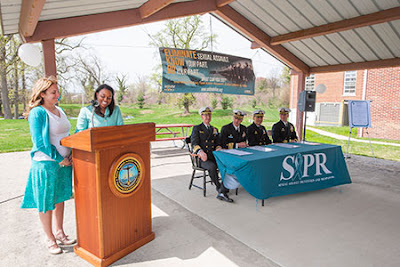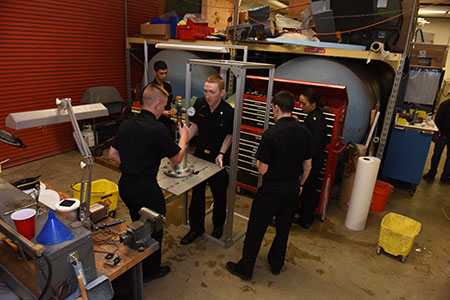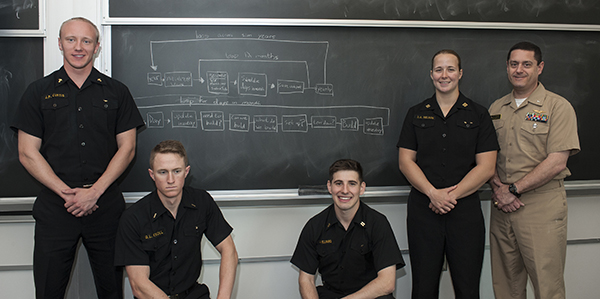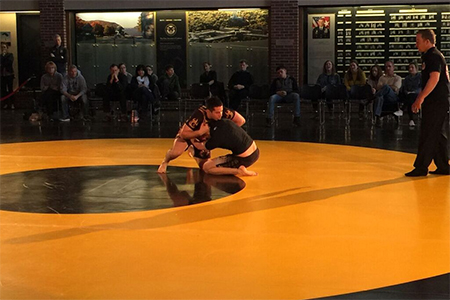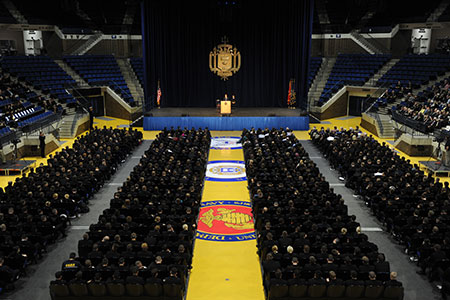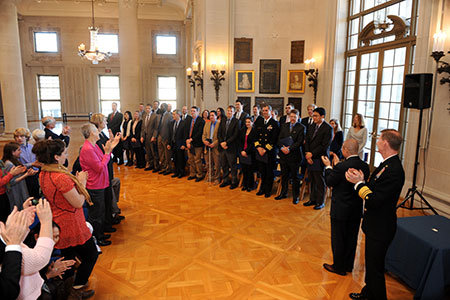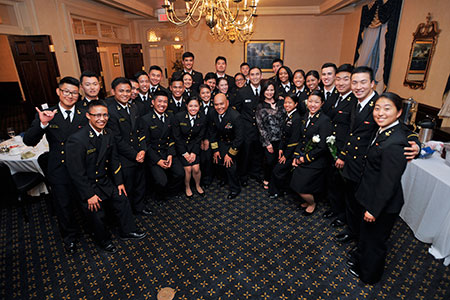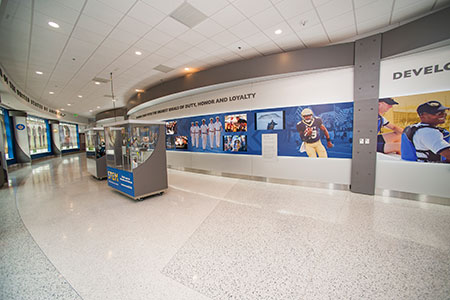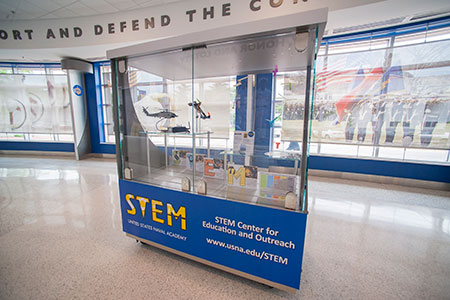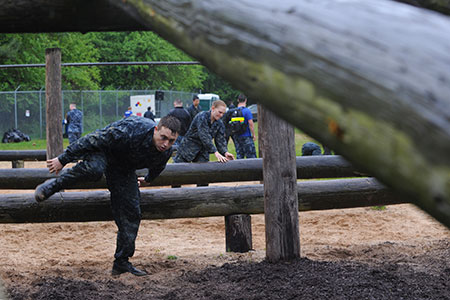By MCSN Brianna Jones
The U.S. Naval Academy (USNA) and U.S. Naval Academy Alumni Association awarded the 2016 Naval Academy Alumni Association Distinguished Graduate Award to three alumni in a ceremony before the Brigade of Midshipmen April 1 in Alumni Hall.
Retired Vice Adm. Robert Dunn (‘51), former Secretary of the Navy John Dalton (’64), and retired Capt. Carl June (’75) received the award for their lifelong achievements and service to the Navy and the nation.
The Distinguished Graduate Award, established in 1999, honors Naval Academy alumni who have given a lifetime of service to the Navy and have made significant distinguished contributions to the nation via their public service.
Dunn’s Navy career spanned 38 years and took him all around the world. Among his many assignments, he commanded a carrier air wing, USS Saratoga (CV 60), and a carrier battle group. He later commanded Naval Military Personnel Command and all Naval Air Forces in the U.S. Atlantic Fleet. Dunn has been awarded with eight Navy Commendation Medals, 28 Air Medals, a Bronze Star, two Distinguished Flying Crosses, and two Silver Stars.
“I was astounded when I found out I had been selected because most of the awardees are a lot younger than I am, so I thought the time had passed me by,” said Dunn. “Being awarded this honor is far beyond the expectations of a lowly plebe way back in 1947. I could have never imagined I would be where I am today.”
During his time at USNA, Dunn lettered in crew, was part of the Lucky Bag staff, and served as class president for three years.
Dalton served as a submarine officer and completed his military service as a lieutenant commander. He received his MBA from Wharton School before joining Goldman Sachs. He has served as chairman and CEO of several corporations and was nominated by President Jimmy Carter as president of the Government National Mortgage Association. Dalton later served as the 70th Secretary of the Navy, receiving his appointment from President Bill Clinton.
“To have been nominated for this award by my classmates is such a wonderful recognition in itself,” said Dalton. “I am humbled, honored, and very grateful, and it is a privilege to be here with whole Brigade of Midshipmen.”
June served in several military medical institutions during his time in the Navy. He first specialized in bone marrow transplants and served as the head of the Immune Cell Biology Department at the Fred Hutchinson Cancer Research Center. Later, his primary focus was on the treatment of infectious diseases such as malaria, HIV and AIDS. Recently, June has developed a new cancer treatment using T-cells infused with an engineered strain of the HIV virus that attacks cancer cells. This treatment has successfully eradicated cancer in more than 200 patients.
After the ceremony, the award winners mingled with midshipmen at an event reception. The future Navy and Marine Corps officers had the opportunity to talk with the 2016 distinguished graduates about their careers and experiences.
“It was amazing listening to the story of their careers and hearing about the things they have done,” said Midshipman 1st Class Jenna Westerberg, spring semester brigade commander. “It is very humbling to be in the presence of these amazing men who got their start at this institution. The fact that I get the chance to interact with influential people like that is such a privilege.”
The U.S. Naval Academy (USNA) and U.S. Naval Academy Alumni Association awarded the 2016 Naval Academy Alumni Association Distinguished Graduate Award to three alumni in a ceremony before the Brigade of Midshipmen April 1 in Alumni Hall.
Retired Vice Adm. Robert Dunn (‘51), former Secretary of the Navy John Dalton (’64), and retired Capt. Carl June (’75) received the award for their lifelong achievements and service to the Navy and the nation.
 |
| Retired CAPT Carl June ('51), former Secretary of the Navy John Dalton ('64) and retired VADM Robert Dunn ('51) receive the USNA Alumni Association Distinguished Graduate Award. |
The Distinguished Graduate Award, established in 1999, honors Naval Academy alumni who have given a lifetime of service to the Navy and have made significant distinguished contributions to the nation via their public service.
Dunn’s Navy career spanned 38 years and took him all around the world. Among his many assignments, he commanded a carrier air wing, USS Saratoga (CV 60), and a carrier battle group. He later commanded Naval Military Personnel Command and all Naval Air Forces in the U.S. Atlantic Fleet. Dunn has been awarded with eight Navy Commendation Medals, 28 Air Medals, a Bronze Star, two Distinguished Flying Crosses, and two Silver Stars.
“I was astounded when I found out I had been selected because most of the awardees are a lot younger than I am, so I thought the time had passed me by,” said Dunn. “Being awarded this honor is far beyond the expectations of a lowly plebe way back in 1947. I could have never imagined I would be where I am today.”
During his time at USNA, Dunn lettered in crew, was part of the Lucky Bag staff, and served as class president for three years.
Dalton served as a submarine officer and completed his military service as a lieutenant commander. He received his MBA from Wharton School before joining Goldman Sachs. He has served as chairman and CEO of several corporations and was nominated by President Jimmy Carter as president of the Government National Mortgage Association. Dalton later served as the 70th Secretary of the Navy, receiving his appointment from President Bill Clinton.
“To have been nominated for this award by my classmates is such a wonderful recognition in itself,” said Dalton. “I am humbled, honored, and very grateful, and it is a privilege to be here with whole Brigade of Midshipmen.”
June served in several military medical institutions during his time in the Navy. He first specialized in bone marrow transplants and served as the head of the Immune Cell Biology Department at the Fred Hutchinson Cancer Research Center. Later, his primary focus was on the treatment of infectious diseases such as malaria, HIV and AIDS. Recently, June has developed a new cancer treatment using T-cells infused with an engineered strain of the HIV virus that attacks cancer cells. This treatment has successfully eradicated cancer in more than 200 patients.
After the ceremony, the award winners mingled with midshipmen at an event reception. The future Navy and Marine Corps officers had the opportunity to talk with the 2016 distinguished graduates about their careers and experiences.
“It was amazing listening to the story of their careers and hearing about the things they have done,” said Midshipman 1st Class Jenna Westerberg, spring semester brigade commander. “It is very humbling to be in the presence of these amazing men who got their start at this institution. The fact that I get the chance to interact with influential people like that is such a privilege.”


